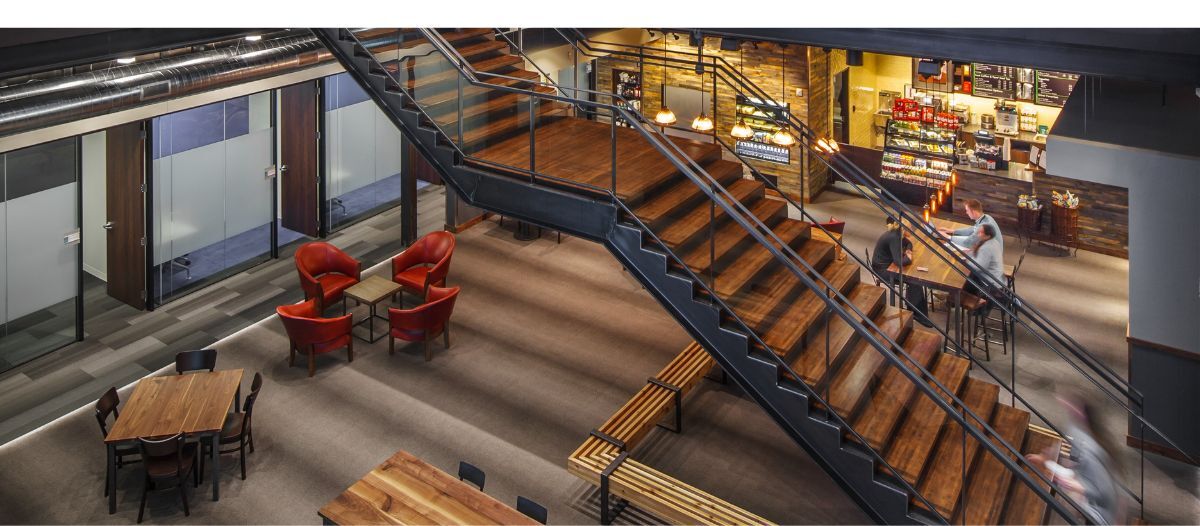Optimizing Real Estate
it’s never been more important than now

Whether owned or leased, there is an inherent and significant cost to real estate. With many corporate portfolios spanning multiple locations, real estate is one of the largest overhead costs impacting profitability. Add the complexity of the COVID-19 pandemic, and the office setting may never be the same.
Now, the predicament is determining how to evolve corporate real estate strategies to respond to rapid change. Deciding to reduce footprint, maintain existing, or even expand, is not easy, especially in this climate. When evaluating portfolios, facility managers must consider employee insights into how space is used, which spaces are underutilized, how often people are physically in the office and what technological changes are required to adapt to feedback received. Even more challenging is the fact that these evaluations are not static; space utilization is, and for the near future will remain, dynamic and fluid. For corporations with a hub-and-spoke model of regional or branch locations, there is also the coworking strategy to consider. This strategy offers an enhanced ability to extend reach beyond current corporate locations, which comes with real estate implications and decisions.
Real estate strategy is more than just an equation
Traditional real estate ratios, such as square foot per person or dedicated 1:1 seats per person, have lost validity with the recent and rapid workplace upheaval. The future corporate real estate equation needs to be more than just a numbers game; it must also be with the lens of employee engagement, culture and work style changes to make the office an attractive destination.
It has become increasingly clear that the quality of space is more important than the quantity. When spaces align with corporate policies and are flexible to support the type of work conducted as well as the employee experience, they can play a significant role in attracting and retaining top talent. Changing work policies, like offering a hybrid approach, have introduced a new equation to the mix. With a hybrid model, real estate needs to adapt; establishing levels of mobility to influence the ultimate flexibility of the space. Executed correctly, a hybrid strategy can also significantly reduce the need for real estate.
Whichever real estate strategy and associated policies are chosen, it is vitally important that corporations align each with their specific culture, goals and values.
Understanding space needs
The first step in understanding real estate space needs is gathering current state data as part of a basic pre-planning exercise. Identifying how people work best today is a good place to start when planning for tomorrow. Pairing these findings with the amount of space needed for tasks will provide more direction on square footage needs. This can be done by surveying the approximate number of staff in the office per week, or through digitally monitoring room usage and overlaying this data with policies on office presence to help drive decisions. Other methods for data collection include occupancy sensors, chair monitors, physical observations, badge usage, or assessing room reservations and number of attendees.
Analyzing this data is where strategy comes into play. Understanding employee expectations, reasoning and schedules can help establish some baseline cultural preferences. Surveying at the employee level is one of the best approaches to gaining this valuable insight. Going a step further and understanding psychological, physical and socioeconomic preferences to find the right balance of space to job function and office presence can result in a space that supports productivity, with a positive impact on employee satisfaction and inclusion.

Fortune 500 Headquarters Corporate Office: Data gathering was the first step to understanding target capacities in a recent project that included the consolidation and renovation of an existing headquarters in response to changing office volume expectations and new remote work policies. Teaming with human resources, the FM group created a survey asking managers to reflect on the number and frequency of staff coming into the office. This data helped establish an initial baseline of required dedicated seats versus shared seats, for both workstations and private offices. The survey, in tandem with manager interviews, also established five new work mode profiles that supported the individuals’ job function and proven frequency in the office. The identified profile space needs were combined with several collaborative areas to form an initial test fit, acting as a means of assessing density and testing the ratio of dedicated seats to shared seats, as well as the amount of focus zones to collaborative areas. Through working sessions, the test fit evolved into a final space plan, resulting in an exciting, unconventional “neighborhood” strategy in support of the density the company was striving for.
Regardless of the designated work mode, it may not be realistic to ask employees to spend their entire day in the same environment. Based on the type of work being performed, there could be several ideal work settings each day to perform at the highest level. Activity zones – like neighborhood, connect, social, recharge or support areas, for example – offer variety and choice throughout the day. Striking a balance between activity zones and focus areas offers employees a level of inclusivity for their unique workstyles and needs.
The impact of policies & culture on space
Space is only part of the equation. The ultimate policies put in place and culture of the organization will also influence real estate decisions. With the great resignation underway, policies that attract and retain staff are rising in importance. The workplace strategy may directly translate to in-office, hybrid, free address or work from home policies.
Designing for remote or hybrid
With the increasing prevalence of remote work, companies are being tasked with establishing their level of support for employees outside of the office. This can include decisions such as providing additional furniture or technology resources in addition to the brick-and-mortar office space.
New Corporate and Manufacturing Headquarters: A discussion regarding the ideal meeting experience was paramount to the design of a new campus during the pandemic. Meeting spaces required extra attention to ensure the “mixed reality sessions” are inclusive and collaborative for those within and outside the room. Basic solutions involve larger digital screens and high-powered, strategically located cameras with the ability to optimize the viewing experience from both sides of the screen. In addition, heightened awareness of what is in the virtual attendee’s viewing area is critical. Everything from workstation orientation to acoustics and lighting can impact the overall experience.
With the rise of the virtual or remote workstyle, another element found in more corporate settings is green rooms or recording studios. These spaces are trending to not only larger, but also in more easily accessible areas. They are shifting out of the back corner of the building, adjacent to the executive or marketing suite, to support the demand and increase of leadership videos, virtual trainings and digital communication methods.
Options for reimagining space use as a smart investment
Everyone wants to know: Is there a silver bullet to making the office a desired place to work and attract people back? Is the right strategy for reducing real estate portfolio and liability, or is it changing existing areas to increase flexibility or adding new amenities? Facility investment decisions will be unique to each corporation based on their individual culture, work type and desired employee experience.
-
Reducing Space Liability through Portfolio Reduction or Leasing – Many organizations have viewed the pandemic as an opportunity to reexamine their lease agreements and where possible, decrease space. In addition to the option of leasing extra space to a new tenant, there are a few other creative real estate solutions to explore. For law clients, standardizing office sizes is becoming more prevalent, providing long-term flexibility by allowing rooms to switch between conference or office space in an instant. With many having nationwide real estate portfolios, releasing the hierarchical expectations of the past allows them to free up or eliminate significant real estate. Still other companies in different industries are taking large swaths of unused warehouse space and leasing to remote servers, receiving historically high rent for the space, while reserving it for future growth and use.
-
Identifying Revenue Generating Solutions – Another growing trend in urban settings is to segment off first-floor retail space to double as a café space for employees as well as being open to the public and functioning as a revenue generating business.
Flexibility in office space
Employees are expected to multitask day in, day out; so, why should space not be expected to do the same? Providing flexible spaces sends a loud message: “Life is not stagnant, and things can change at any moment. By incorporating flexibility, we are planning for the future.” When space can function dually, it gives employees more options for how they want to work as not everyone needs the same thing to be productive. Providing variety allows the office experience to flex, mold and change, giving users more control and resulting in happier, more satisfied employees. That is what many people enjoy about being home, the control over their environment; it can be compelling to have a comparable level of control in an office setting. There are many ways flexibility is being heightened in the office environment including:
-
Furniture-based solutions – These offer a user control aspect, with the ability to seamlessly divide open office spaces into collaboration zones or provide visual and acoustical privacy when needed. Also, movable furniture, like adaptable workstations on wheels, allows employees to create their own work environment, enhancing collaboration and connection with the option to easily shift back.
-
Conferencing and Assembly Spaces – Increasing flexibility in large rooms is of increasing importance. Telescopic seating maintains the appearance of auditorium seats, but functions like bleachers, collapsing and banking across a wall, allowing the space to function as a tradeshow, banquet hall or event space.
-
Dual Purpose Space – Real estate can (and should) support more than one use, like an atrium with communicating stairs that double as an all-hands space.
-
Operable Partitions and Demountable Walls – By providing ease in reconfiguring and expanding conference/training space types, these reduce overall costs in the short and long term.
The rise in amenity-based spaces
Another real estate strategy is to focus on providing amenities and experiences that cannot be duplicated at home to entice people into the office. There is a growing realization after working remotely that some portion of dedicated employee space can be reallocated to collaborative space. Some examples of this include:
-
Conference Centers – Many clients are rethinking entire swaths of traditional workstation office space and reconfiguring them into shared spaces that function as flexible and collaborative, social and customer-facing conference centers.
-
Outdoor Spaces – When talking about real estate reuse, it is not just indoor spaces that should be considered. The outdoors can be harnessed and reinvented with outside gathering spaces, gardens or rooftop patios to offer employees relaxing views and access to nature.
-
Fitness and Wellness – To support the ever-increasing emphasis on well-being, employers are looking at ways to provide social and healthy outlets for employees with class-based fitness, meditation spaces and increased quiet and private spaces to take telehealth visits.
-
Gathering Spaces – Providing social interaction is often one of the most cited attractions to the work setting; defining spaces that support happy hours, eating and social activity are important to foster and build culture.
So, what is the right real estate strategy to attract people back to the office?
As real estate strategy for the future develops, office planning will need to be done with a thoughtful lens to support meaningful employee engagement, innovation and positive cultures. Looking at the real estate equation as not just a metric or ratio but a meaningful tool to promote engagement, will help revive cultures that have suffered during the pandemic. Understanding worker modes to balance personal and shared spaces that promote connection among employees will be key as companies start to attract employees back to the office.

Jennifer Herr, NCIDQ, LEED AP ID+C is an associate senior interior designer at EUA. She leverages her leadership abilities, strategic thought process and more than 20 years of extensive design experience throughout the U.S. and Asia Pacific to produce the best results possible for her clients. Working collaboratively alongside the project team, she uses a wide variety of skills to ensure the client’s vision is at the forefront of design. Problem solving is her passion, and when coupled with her commitment to listening, results in informed design solutions that align with project goals and exceed client expectations.

Allison Pfeifer, NCIDQ is an associate senior interior designer at EUA. Her fascination with how the built environment shapes culture, inspires innovation and increases energy is her foundation for specializing in workplace design. Her experience across a wide variety of industries gives her a unique strategy perspective to share with clients. She spearheads EUA’s Emerging Professional Group, is a member of Tempo Milwaukee's Emerging Women Leaders and is a graduate of the Future Milwaukee Leadership program.
Read more on Project Management and Real Estate
Explore All FMJ Topics









